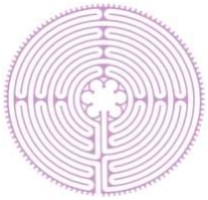Walk and Pray
‘Look and ask for the ancient paths, where the good way lies; and walk in it and find rest for your souls.’ (Jeremiah 6: 16)
Some time ago, a well-known colleague, Rob Frost, now gone to glory, said on Radio that he prayed best when walking the dog! This struck a cord and so, I suspect, it did for many others at the time. So too, you may find a place in your prayer life for walking in prayer on a regular or occasional basis, with or without a dog!
Of course there are the long journeys or walks for a pilgrimage which are very special but there are also those special places, perhaps by a river or up a mountain, where we have to get off the bus or out of the car and walk. At a fundamental level some places we walk renew us and the act of or rhythm in walking helps to ground us and centre us. There is a special challenge here, if we live in a big city, but there still may be found paths that are designed to assist prayer, such as labyrinths, even in the cities.
‘Your word is a lamp to my feet and a light to my path’ (Psalm 119:105)
Lord Jesus, you have promised to be our guide,
Walk with us on our journey.
Lord Jesus, you promised never to abandon us.
Walk with us on our journey.
Lord Jesus, our security, even in the shadow of death.
Walk with us on our journey.
Lord Jesus, in the laughter and rejoicing of our days.
Walk with us on our journey.
Lord Jesus, through the companionship of friends.
Walk with us on our journey.
Lord Jesus, the Way, the Truth and the Life;
Walk with us on our journey and lead us home. Amen
Labyrinth
Labyrinths are ancient pathways found across the world. The winding path helps us to ‘unwind’, to let go and rest in God. Members of the early church as well as Medieval Pilgrims have used them as a support for prayer.
They are not the same as a maze. A Maze has a number of dead ends and is designed to get you lost or to frustrate. A labyrinth is only one path in and one path out, by entering right to the centre and then retracing your steps to exit. If you stay on the path you cannot get lost.
Today, Labyrinths are being created in churches, retreat centres, schools, hospices and cathedrals to offer a spiritual space for prayer and reflection providing a stilling space, space in a busy world.
‘… did not our hearts burn within us as he talked to us on the road …’ (Luke 24:32)
There is no right or wrong to walk a labyrinth … no set rules, or pace, just follow the path in your own time. This short guide may assist you.
Your labyrinth prayer
This time can be as open or as focussed as you like.
You might want to simply enter the labyrinth and walk with the Lord …
Or, before you enter the labyrinth, you might like to take time to:
- Read and reflect on a line or two from Scripture
- Hold a memory or a photo of a loved one you wish to remember or to pray for
- Consider an experience in your life where you are seeking healing or forgiveness
- Think about a celebration or a special time and walk a prayer of thanksgiving in the labyrinth.
There are many other prayer walks and suggestions on www.pilgrimpaths.co.uk
Pilgrimage

Pilgrimage has always been an important part of Christian faith. The desire of Christians to grow in their relationship with God is often described as a journey and going on pilgrimage is a way of letting the outward journey of our bodies enrich and enable the inner journeys of our hearts and minds.
The mode of travel can be important. Some walk, finding the slower pace helps them to notice and engage with the world around them as well as with their inner self and God. Others run, cycle, ride on horseback or use other methods of transport.
The destination is significant too. Most pilgrim routes are ancient, taking people to places made holy by events that have happened there, in the footsteps of those who have gone before them or the presence of shrines or relics of holy people.
For those who find walking difficult, other flexible transport can be used, stopping off enroute to appreciate waymarks and sites of importance to past pilgrims.
Popular destinations include: Canterbury, St Albans, Walsingham, Santiago de Compostella, Iona, Lindisfarne, Jerusalem or Bethlehem.
The Labyrinth in Art – tracing the path
If you find it difficult to walk, or you don’t have an opportunity to visit or hire a labyrinth, then there are other ways to pause, to centre in a similar way and use your fingers or a crayon to ‘walk the labyrinth’. A picture of a labyrinth or a small cloth or a carved one may be used. Resources for this are found at www.pilgrimpaths.co.uk including seasonal and other labyrinth resources.
Trace the path with your finger or if on paper, with a crayon or pen and use the slow steady movement to centre and focus, as with the labyrinth prayer above. Celtic patterns and embroidery have a similar effect.

There are a many labyrinths around the country. For a directory of labyrinths, in many settings, across the world go to World Wide Labyrinth Locator.
Finger labyrinths can be used for prayerful reflection when it is not possible to walk a full sized labyrinth. Large cloth/ matting ones are available for church events too. www.pilgrimpaths.co.uk
‘You will reveal the path of life to me, give me unbounded joy in Your presence …’ (Psalm 16: 1)
Places to walk and wonder
Look out for places to wander and wonder, such as a local museum and walking by a local river. You will be probably able to listen to God better there or simply be more open and find peace as you pause. This is a God given moment.
Acknowledgements: With many thanks to Barbara Wallace - Pilgrim Paths Ltd. www.pilgrimpaths.co.uk - Prayer guide – Finger labyrinths
Other resources: ‘Prayer in the Streets: Using the Labyrinth as Symbol and Tool for an Urban Prayer Life’ Antonia Lynn – from Andrew Walker ed. ‘Discovering the Spirit in the City’ See more at: www.bloomsbury.com/uk/discovering-the-spirit-in-the-city-9781441110824/
This article by Revd Pearl Luxon was first published in the Methodist Recorder and is reproduced with permission. © Methodist Recorder 2017